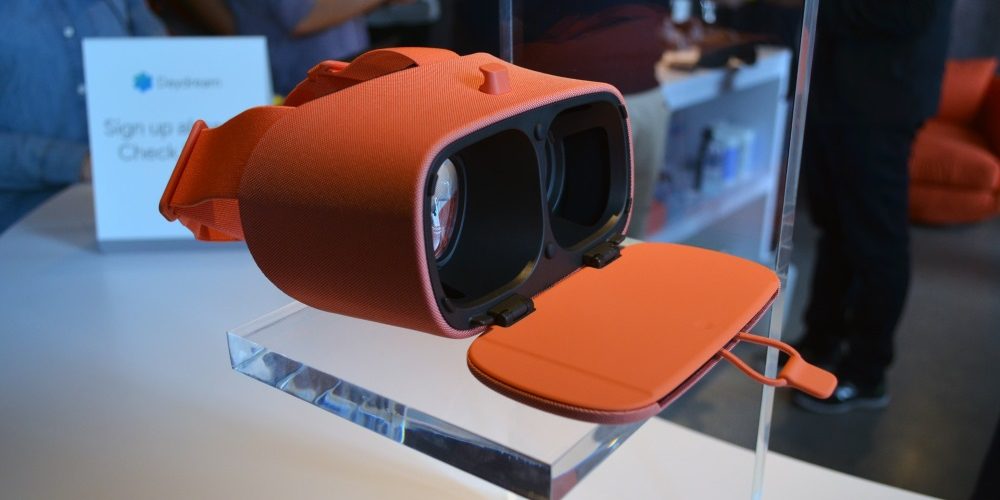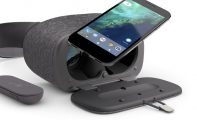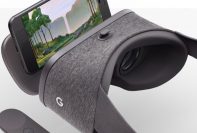When the PC-tethered VR headsets were far beyond the reach of a majority of people due to their high prices and when standalone VR headsets weren’t available, the only source of VR was smartphone-powered VR headsets.
These extremely cheap VR headsets consist of an empty shell that requires a powerful smartphone to be placed on the front.
It acts as the powerhouse, as well as the display for the VR experiences you wish to view.
Since the aggressive competition between the HTC Vive and the Oculus Rift has brought the prices of PC-tethered VR headsets down to less than the half of what they once were and standalone VR headsets are dominating the cheaper side of the market, the position of smartphone-powered VR headsets is an important question.
While the smartphone-powered VR headsets still have some value in the market, they do seem to have a grim future.
This is because standalone VR headsets are similar to other smartphone-powered VR headsets.
They are better since they have dedicated chipsets powering the VR experiences and built-in display for it.
The only advantage that smartphone-powered VR headsets have in the market today, is their cheaper price tags.
However, you must consider the investment that you must make to buy a powerful smartphone if you don’t have one that supports the mobile VR headset that you’re about to buy.
Therefore, the relevance of the mobile VR headsets being in the market is in question.
However, we know that these headsets do attract many consumers and aren’t completely irrelevant today.
Google invested time and other resources into upgrading the original Google Daydream View and releasing the second generation of its mobile VR headset in the latter half of 2017.
The headset is often referred to as Google Daydream View 2 or View 2nd Generation, or View (2017).
Google Daydream View is a very popular mobile VR headset that is a substantial improvement over the original device.
These improvements put the Daydream View 2 in direct competition with the Samsung’s Gear VR headset.
This review will focus on the design, performance, and compatibility of Google Daydream View (2017).
Many of its traits will be compared to those of the Samsung Gear VR.
What is Google Daydream View?
Google Daydream View could be called a shell for VR.
By itself, the Daydream View is just a strap with a spacious front and two display lenses that serve no purpose.
Once you place a compatible smartphone in this shell, the fun begins.
The Daydream View uses the smartphone to project the display of the VR content through the lenses to your eyes so that you can experience the content with full immersion.
The Daydream View is a doorway that you can buy to make your smartphone capable of showing VR content in an immersive environment.
Design
The Google Daydream View 2nd generation is surprisingly more popular than the original Daydream View.
This is because the original Daydream View was launched in an era when standalone VR headsets were just a concept.
At that time, mobile VR headsets were the real deal after PC-tethered high-end VR headsets.
When the second generation of the Daydream View was launched, mobile VR headsets like the Oculus Go, Mirage Solo, and HTC Vive Focus were either launched or were about to be launched.
At that time, mobile VR headsets were losing their popularity and somehow, the Daydream View 2nd generation was able to become more popular than its predecessor.
Better Fabric
The main reasons why this occurred are improvements in the design of the device.
This made the experience of using the Google Daydream View better than ever.
One of the major changes in the design of the new Google Daydream View was the material.
The original Daydream View was covered in a soft cloth-like fabric that, even though it was very comfortable, was not very strong and durable.
The new fabric that covers the latest generation of the Daydream View is made of a much harder and more durable material.
The difference is like the fabric of a soft couch destined for your living room versus the fabric for a rugged and durable chair to be used in a busy office’s waiting room.
The soft couch is great for comfort. However, it can’t withstand frequent heavy use.
By contrast, the waiting room chair, while not that comfortable, can withstand daily heavy use.
It is almost impossible to make a comparison with the Samsung Gear VR.
This is because the Samsung Gear VR has hard plastic instead of fabric covering the outside of the device.
However, this does mean the Samsung Gear VR is that many times stronger and more durable than the Daydream View 2.
While the Daydream View 2 has stylish looks, the Samsung Gear VR has a more durable build and classier looks.
Stylish Stitch Work and Color Schemes
Even though the new fabric is rough and rugged, the overall look of the Google Daydream View is stylish and elegant.
This is largely because of the attractive pattern in which the fabric has been stitched and the available color schemes.
The Google Daydream View is available in Fog, Coral, and Charcoal colors.
Each color scheme is uniquely beautiful and stylish.
It is not possible to compare Samsung’s Gear VR headset with the Daydream View 2 on this feature since the material on both of the headsets is different.
However, the Google Daydream View 2 is better than the Gear VR in this area, since it is available in different color schemes, while the Gear VR only has one.
Lighter Design
One of the most important changes in the new design is that the overall weight of the device has been reduced.
The Daydream View 2 is a well-balanced and light VR headset, which feels very comfortable when worn.
There is no extra pressure on your forehead and the straps are not uncomfortable at all.
Samsung has had sufficient time to perfect the comfortable design of the Gear VR, to be since it was launched much earlier than the original Daydream View.
It has also been consistently upgraded by the manufacturer.
Both VR headsets offer a great deal of comfort to their users.
A Removable Third Strap
Another major design change in the Daydream View 2, is the addition of the third strap.
You have the option of removing it if you just don’t like how it feels on your head.
The third strap extends from the top of your head to the back, where the other two straps meet.
The third strap adds to the ease of use of the VR headset as a whole because, with it, you can take the VR headset on or off like a simple cap.
One thing that we noticed while experimenting with the latest Daydream View, was that with the strap, the two straps that extend from the side of your head didn’t seem to grip the head as tightly as we expected it to.
We were constantly distracted by the feeling that the headset is somehow slipping if we quickly rotated our head.
It is also important to note was that even though the third strap helps in balancing the weight of the VR headset, the whole contraption is still oriented toward the front and you can feel the weight on your forehead.
However, since this is a problem that the VR headset manufacturer could solve, it not counted as a flaw, although it is worth mentioning.
The Gear VR comes with only two straps that extend from the sides of your head and meet at the back.
While many people are comfortable with this configuration, we felt much more comfortable while using the third strap.
We wished that the same strap would have been an option in the Samsung Gear VR headset.
Too Tight on The Forehead
To get the right focus, we noticed that the headset has to sit fairly high on your forehead.
This shouldn’t be a problem.
However, unfortunately, it was with the Daydream View 2.
The side straps of the Daydream View aren’t attached from the center of the headset’s sides.
In our desperate attempts to set the headset so that the focus was perfect, we had to tighten the straps too much.
With this setting, the meeting point of the straps at the back our head would dig in a bit after prolonged usage.
As a result, it felt uncomfortable.
If you used the Daydream View with this setting for more than half an hour in a single session, a prominent red line will appear on your forehead.
It looks like you had put a tight rubber band on your forehead.
Moreover, many of us felt the blood flow increasing in the area, which indicated that the headset’s straps were much tighter than they should be.
Compared to the Daydream View 2, the Gear VR has a much better design for this feature.
This is because the Gear VR is designed so that the right focus can be found in a larger range of settings.
By contrast, the Daydream View 2 offers the perfect focus, only when the headset is placed high on the forehead.
This required us to overtighten the straps.
Moreover, the focus wheel in the Samsung Gear VR is a great tool to adjust the focus, even if it is a bit off.
This allows you to set the straps to your comfort and then adjust the focus.
Unfortunately, Daydream View 2 has no such mechanism.
Soft and Comfortable Padding
The padding inside the headset is soft and cushiony and feels light on the face.
Many mobile VR headsets which featured cloth-based padding on the inside of the headset, would get very uncomfortable after some time.
This is because the cloth started scratching or “eating” your skin.
Sweat also causes many cloth-based paddings to get very uncomfortable.
It makes it impossible for you to share your headset with friends or family, knowing that every player’s sweat is on the padding.
The padding on The Google Daydream View 2 was very nice and soft.
It didn’t feel uncomfortable or scratchy, even after prolonged sessions.
The Daydream View 2 is clearly a greatly improved headset from its predecessor in this regard.
As with many aspects of the design of the Daydream View 2, the Gear VR had enough time for Samsung to improve upon the original design and make the headset much more comfortable from the inside.
When we compared the experience of both headsets, it was hard to find a clear winner in the comfort of the inside of the headset.
Spacious and More Isolated
One of the main problems with the original Daydream View was that the headset leaked light from the bottom to the isolated area inside.
This caused distraction and irritation.
The new design was a definite improvement, since considerably less light leaks from the bottom of the headset.
While the inside of the headset is still not perfectly isolated, the improvement makes the VR experience much more immersive.
Another very important feature of the Daydream View was that it allows a large number of glass frame types to be fitted easily inside, making it a great VR headset for people who wear glasses.
A very small amount of light also leaks from where the smartphone rests.
However, this is usually not a problem.
It does sometimes become a problem, when the light coming from the outside hits the lens at an extreme angle and causes a lens flare effect.
While the small amounts of light leaking inside can be ignored after about five minutes of gameplay, the lens flare effect immediately becomes a distraction and ruins the immersion.
Therefore, it would be a better idea to use the Daydream View 2 in a dark room.
Since the Samsung Gear VR only supports Samsung’s latest flagships, the smartphone slot in the Gear VR is built to fit the smartphone perfectly.
This allowed Samsung to create a front panel that completely fits the smartphone inside and shuts off completely.
It does not allow even a single ray of light to enter from the front of the headset to the inside.
In our opinion, this design choice was only available, because the Gear VR only supports a small variety of smartphones and Samsung clearly capitalized on it.
The Daydream View supports a large variety of smartphones that come in different sizes.
This forced Google to come up with a universal design which, unfortunately, allows some light to enter.
For people who wear glasses, the focus wheel on the Samsung Gear VR allows users to adjust the focus so that you don’t even need to wear glasses to enjoy VR with the Gear VR.
Efficient Way of Fitting the Controller
The Daydream View 2 offers the most effective way to keep your controllers: a loop of the strap where the three straps meet.
No other VR headset manufacturer offers this cool and efficient way of tucking the controller away safely.
This eliminates the worries of forgetting the controller somewhere or misplacing it.
Performance
There isn’t much to discuss the performance of the Daydream View 2.
This is because it isn’t performing anything at all.
As mentioned earlier, the Daydream View two is just a shell.
However, we can discuss the performance and the working of the controller that comes with it.
Using the Google Daydream platform is pretty easy to figure out with the controller.
The controller is used as a point-and-click remote, that allows you to navigate around different menus and interact in VR apps.
Connection with Smartphone
While the controller works great, it did lose the connection with the smartphone a few times, while we were experimenting with it.
Clicking the home button a few times, immediately reconnected the controller.
Sometimes, these random disconnects also caused a few associated issues.
For instance, the view would abruptly be re-centered.
This becomes a problem when your head is in an uncomfortable position.
For instance, if you were looking up on the ceiling and the view got recalibrated, the virtual center of the virtual space is set to that position of the smartphone.
Therefore, you will have to look at the ceiling, to look at the center of the virtual space.
You will have to stop the app, bring your head back to a comfortable position, recalibrate the smartphone’s tracking and start again.
This didn’t happen often but it was quite frustrating.
Positional Tracking
The Daydream controller does not feature positional tracking.
This isn’t a major which isn’t a flaw since the Oculus Touch controller also lacks this feature.
Since the Daydream View supports the Daydream platform and the developers are aware of this limitation, most of the apps and games on the Google Daydream platform employ creative ways to make the controller usable.
For instance, the controller is used as a wand in the Fantastic Beasts VR experience.
Of course, you can’t draw patterns and shout spells with the wand.
However, you can use it to interact with the virtual world and activate stuff all around.
It’s a cool way to interact in the game and doesn’t let you feel like the controller is irrelevant at all.
Compatibility
One serious problem that we found in the original Daydream View, was that for a smartphone-based VR headset, the Daydream View simply didn’t support a large variety of smartphones.
Google has clearly taken that critique into account and the Daydream View 2 has a huge lineup of compatible smartphones.
The list is robust.
The variety allows us to choose a smartphone that we are also comfortable using as our primary cellphone.
All of the smartphones listed below are compatible with the Daydream View 2 and the Daydream VR platform:
- Google Pixel Series
- Samsung Galaxy S9 and S9+
- Samsung Galaxy S8 and S8+
- Asus ZenFone AR
- LG V30
- Samsung Galaxy Note 8
- Motorola Moto Z2 Force
- ZTE Axon 7
- Motorola Moto Z and Z Force
- Huawei mate 9 Pro and Porsche Design mate 9
This is a huge list.
All of the smartphones on the list are very popular throughout the world.
Compared to other mobile VR headsets, the Google Daydream View 2 is the most accepting mobile VR headset with the largest list of compatible smartphones.
Conclusion
Even if the Daydream View 2 is built for us to take outside with us to enjoy, it will still take a lot of time to find the courage to take our VR headsets out in public.
This is because people stare at you with prying eyes, like you have forgotten to wear your pants before going out and vice versa.
The Google Daydream platform is a pretty decent VR library and features a considerably large number of VR experiences, that include VR games and VR videos.
Therefore, trying the Daydream View 2 is definitely worth a shot.
It has the potential to motivate you to get into serious VR, by buying a high-end VR headset.
If you are a beginner and want to check VR out, the Daydream View 2 might be the best headset you can buy, since it supports a large number of smartphones, one of which you probably already have.
The Google Daydream View 2 is one of the cheapest ways to get into virtual reality.
However, the headset is quite uncomfortable, when you use it for more than half an hour in a single session.
If you want to experiment with VR, test out VR apps and view VR videos, the Daydream View 2 is an excellent choice.
However, if you want to pay casual VR games for hours, the Daydream View 2 is probably not the best choice.


